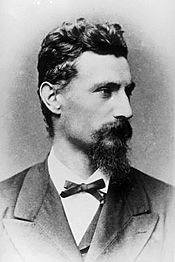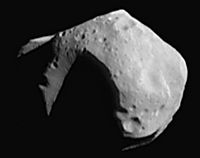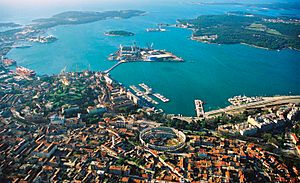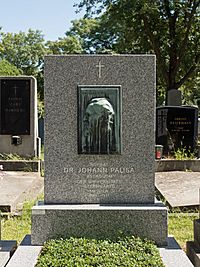Johann Palisa facts for kids
Quick facts for kids
Johann Palisa
|
|
|---|---|
 |
|
| Born | 6 December 1848 Troppau, Austrian Silesia, Austrian Empire
|
| Died | 2 May 1925 (aged 76) |
| Nationality | Austrian |
| Alma mater | University of Vienna |
| Known for | asteroids |
| Awards | Lalande Prize, 1876 Valz Prize, 1906 |
| Scientific career | |
| Fields | astronomy |
| Institutions | University of Vienna |
Johann Palisa (6 December 1848 – 2 May 1925) was an Austrian astronomer, born in Troppau, Austrian Silesia, now Czech Republic. He was a prolific discoverer of asteroids, discovering 122 in all, from 136 Austria in 1874 to 1073 Gellivara in 1923. Some of his notable discoveries include 153 Hilda, 216 Kleopatra, 243 Ida, 253 Mathilde, 324 Bamberga, and the near-Earth asteroid 719 Albert. Palisa made his discoveries without the aid of photography, and he remains the most successful visual (non-photographic) asteroid discoverer of all time. He was awarded the Valz Prize from the French Academy of Sciences in 1906. The asteroid 914 Palisana, discovered by Max Wolf in 1919, and the lunar crater Palisa were named in his honour.
Contents
Biography
Palisa was born on 6 December 1848, in Troppau in Austrian Silesia (now called Opava and located in the Czech Republic). From 1866 to 1870, Palisa studied mathematics and astronomy at the University of Vienna; however, he did not graduate until 1884. Despite this, by 1870 he was an assistant at the university's observatory, and a year later gained a position at the observatory in Geneva. A few years later, in 1872, at the age of 24, Palisa became the director of the Austrian Naval Observatory in Pula. While at Pula, he discovered his first asteroid, 136 Austria, on 18 March 1874. Along with this, he discovered twenty-seven minor planets and one comet. During his stay in Pula he used a small six-inch refractor telescope to aid in his research.
Palisa became director of the Pula observatory, with the rank of commander, until 1880. In 1880 Palisa moved to the new Vienna Observatory. While at the observatory he discovered 94 comets by visual means.
In 1883 he joined a French expedition to Caroline Island to observe the Solar eclipse of 6 May 1883. During the expedition, he joined to observations for the search for the hypothetical planet Vulcan, as well as collecting samples of insects for the Vienna Museum of Natural History. In memory of this expedition, he named the asteroid 235 Carolina after Caroline Island.
In 1885, Palisa offered to sell the naming rights of some of the minor planets he discovered, in order to fund his travels to observe the Solar eclipse of 29 August 1886. However he sold just a small number of these naming rights and apparently did not go.
Palisa and Max Wolf worked together to create the first star atlas created by photographic plates, the Palisa–Wolf Sternkarten, also known as the Palisa-Wolf-Star-Maps, published in 1899, 1902, 1908. In 1908, Palisa published the Sternenlexikon, mapping the skies from declinations −1° to +19°. That same year, he became the vice director of the Vienna Observatory. He retired from administrative duties in 1919, but kept observation rights. Palisa continued to discover asteroids until 1923. He died on 2 May 1925.
Discoveries

Between 1874 and 1923 Palisa discovered 122 asteroids ranging from 136 Austria to 1073 Gellivara and the much later numbered Mars-crosser 14309 Defoy, respectively (see table below). He made his discoveries at the Austrian Naval Observatory at Pola (538) and at the Vienna Observatory. He also discovered the parabolic comet C/1879 Q1 in August 1879.
One of his discoveries was 253 Mathilde, a 50-kilometer sized C-type asteroid in the intermediate asteroid belt, which was visited by the NEAR Shoemaker spacecraft on 27 June 1997. The robotic probe passed within 1200 km of Mathilde at 12:56 UT at 9.93 km/s, returning imaging and other instrument data including over 500 images which covered 60% of Mathilde's surface. Only a small number of minor planets have been visited by spacecraft.
Palisa made all of his asteroid discoveries visually. Even though Max Wolf had revolutionised the process of asteroid discovery by introducing photography in the 1890s, Palisa continued to trust on visual observations. His final discovery, 1073 Gellivara, was the last asteroid that was found visually. Johann Palisa remains the most successful visual (non-photographic) asteroid discoverer of all time.
It should also take 73 years after the last asteroid discovery of 1073 Gellivara until the next minor planet 9097 Davidschlag was discovered by Austrian amateur astronomers .
| 136 Austria | 18 March 1874 |
| 137 Meliboea | 21 April 1874 |
| 140 Siwa | 13 October 1874 |
| 142 Polana | 28 January 1875 |
| 143 Adria | 23 February 1875 |
| 151 Abundantia | 1 November 1875 |
| 153 Hilda | 2 November 1875 |
| 155 Scylla | 8 November 1875 |
| 156 Xanthippe | 22 November 1875 |
| 178 Belisana | 6 November 1877 |
| 182 Elsa | 7 February 1878 |
| 183 Istria | 8 February 1878 |
| 184 Dejopeja | 28 February 1878 |
| 192 Nausikaa | 17 February 1879 |
| 195 Eurykleia | 19 April 1879 |
| 197 Arete | 21 May 1879 |
| 201 Penelope | 7 August 1879 |
| 204 Kallisto | 8 October 1879 |
| 205 Martha | 13 October 1879 |
| 207 Hedda | 17 October 1879 |
| 208 Lacrimosa | 21 October 1879 |
| 210 Isabella | 12 November 1879 |
| 211 Isolda | 10 December 1879 |
| 212 Medea | 6 February 1880 |
| 214 Aschera | 29 February 1880 |
| 216 Kleopatra | 10 April 1880 |
| 218 Bianca | 4 September 1880 |
| 219 Thusnelda | 30 September 1880 |
| 220 Stephania | 19 May 1881 |
| 221 Eos | 18 January 1882 |
| 222 Lucia | 9 February 1882 |
| 223 Rosa | 9 March 1882 |
| 224 Oceana | 30 March 1882 |
| 225 Henrietta | 19 April 1882 |
| 226 Weringia | 19 July 1882 |
| 228 Agathe | 19 August 1882 |
| 229 Adelinda | 22 August 1882 |
| 231 Vindobona | 10 September 1882 |
| 232 Russia | 31 January 1883 |
| 235 Carolina | 28 November 1883 |
| 236 Honoria | 26 April 1884 |
| 237 Coelestina | 27 June 1884 |
| 239 Adrastea | 18 August 1884 |
| 242 Kriemhild | 22 September 1884 |
| 243 Ida | 29 September 1884 |
| 244 Sita | 14 October 1884 |
| 248 Lameia | 5 June 1885 |
| 250 Bettina | 3 September 1885 |
| 251 Sophia | 4 October 1885 |
| 253 Mathilde | 12 November 1885 |
| 254 Augusta | 31 March 1886 |
| 255 Oppavia | 31 March 1886 |
| 256 Walpurga | 3 April 1886 |
| 257 Silesia | 5 April 1886 |
| 260 Huberta | 3 October 1886 |
| 262 Valda | 3 November 1886 |
| 263 Dresda | 3 November 1886 |
| 265 Anna | 25 February 1887 |
| 266 Aline | 17 May 1887 |
| 269 Justitia | 21 September 1887 |
| 273 Atropos | 8 March 1888 |
| 274 Philagoria | 3 April 1888 |
| 275 Sapientia | 15 April 1888 |
| 276 Adelheid | 17 April 1888 |
| 278 Paulina | 16 May 1888 |
| 279 Thule | 25 October 1888 |
| 280 Philia | 29 October 1888 |
| 281 Lucretia | 31 October 1888 |
| 286 Iclea | 3 August 1889 |
| 290 Bruna | 20 March 1890 |
| 291 Alice | 25 April 1890 |
| 292 Ludovica | 25 April 1890 |
| 295 Theresia | 17 August 1890 |
| 299 Thora | 6 October 1890 |
| 301 Bavaria | 16 November 1890 |
| 304 Olga | 14 February 1891 |
| 309 Fraternitas | 6 April 1891 |
| 313 Chaldaea | 30 August 1891 |
| 315 Constantia | 4 September 1891 |
| 320 Katharina | 11 October 1891 |
| 321 Florentina | 15 October 1891 |
| 324 Bamberga | 25 February 1892 |
| 326 Tamara | 19 March 1892 |
| 569 Misa | 27 July 1905 |
| 583 Klotilde | 31 December 1905 |
| 652 Jubilatrix | 4 November 1907 |
| 671 Carnegia | 21 September 1908 |
| 687 Tinette | 16 August 1909 |
| 688 Melanie | 25 August 1909 |
| 689 Zita | 12 September 1909 |
| 703 Noëmi | 3 October 1910 |
| 710 Gertrud | 28 February 1911 |
| 711 Marmulla | 1 March 1911 |
| 716 Berkeley | 30 July 1911 |
| 718 Erida | 29 September 1911 |
| 719 Albert | 3 October 1911 |
| 722 Frieda | 18 October 1911 |
| 723 Hammonia | 21 October 1911 |
| 724 Hapag | 21 October 1911 |
| 725 Amanda | 21 October 1911 |
| 728 Leonisis | 16 February 1912 |
| 730 Athanasia | 10 April 1912 |
| 734 Benda | 11 October 1912 |
| 750 Oskar | 28 April 1913 |
| 782 Montefiore | 18 March 1914 |
| 783 Nora | 18 March 1914 |
| 794 Irenaea | 27 August 1914 |
| 795 Fini | 26 September 1914 |
| 803 Picka | 21 March 1915 |
| 827 Wolfiana | 29 August 1916 |
| 828 Lindemannia | 29 August 1916 |
| 867 Kovacia | 25 February 1917 |
| 876 Scott | 20 June 1917 |
| 902 Probitas | 3 September 1918 |
| 903 Nealley | 13 September 1918 |
| 932 Hooveria | 23 March 1920 |
| 941 Murray | 10 October 1920 |
| 964 Subamara | 27 October 1921 |
| 975 Perseverantia | 27 March 1922 |
| 996 Hilaritas | 21 March 1923 |
| 1073 Gellivara | 14 September 1923 |
| 14309 Defoy | 22 September 1908 |
Family
Palisa married his second wife, Anna Benda, in 1902. Asteroid 734 Benda is named after her. He also named minor planets after other members of his family: 320 Katharina after his mother, Katherina, 321 Florentina for his daughter Florentine.
His granddaughter was Gertrud Rheden, wife of astronomer Joseph Rheden. Asteroid 710 Gertrud is named after her.
Honors and awards
In 1876 Palisa was awarded the Lalande Prize.
Palisa was awarded the Valz Prize from the French Academy of Sciences in 1906.
The Phocaea main-belt asteroid 914 Palisana, discovered by Max Wolf in 1919, and the lunar crater Palisa were named in his honour. Minor planets 902 Probitas, 975 Perseverantia, and 996 Hilaritas that he discovered were given names after his death for traits qualities associated with him: adherence to the highest principles and ideals, perseverance and happy or contented mind. Names were given by Joseph Rheden with the support of Palisa's second wife, Anna.
Minor planet 1152 Pawona is named after both Johann Palisa and Max Wolf, in recognition of their cooperation. The name was proposed by Swedish astronomer Bror Ansgar Asplind. Pawona is a combination of "Palisa" and "Wolf" (Pa, Wo) joined with a Latin feminine suffix.
See also
 In Spanish: Johann Palisa para niños
In Spanish: Johann Palisa para niños



